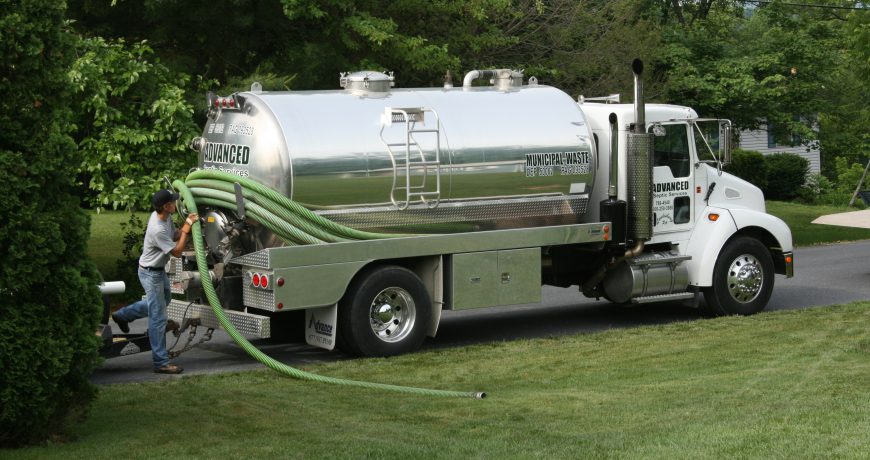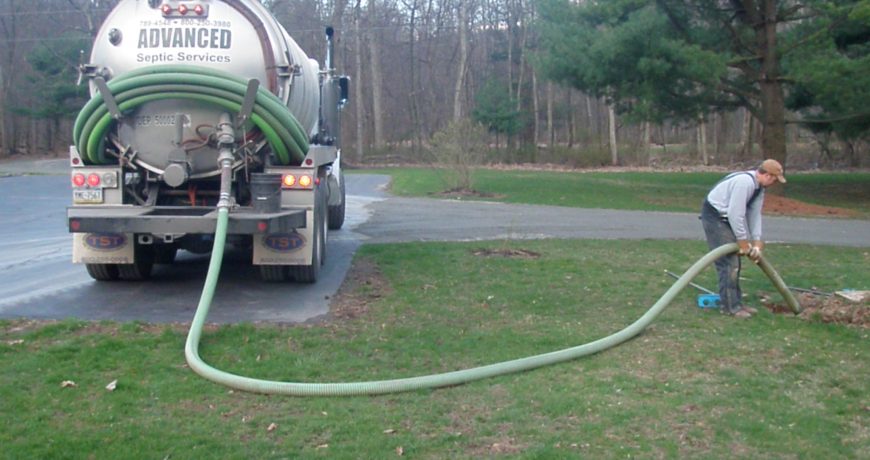If you ever need to have a Septic/plumbing problem solved this is the company you must use. Highly Professional, quick response and dedicated to doing the job right the first time. I highly recommend any service they can provide. Been with them for 16 years and was never disappointed.
Septic Tank Cleaning Services
We provide septic tank cleaning services for both commercial and residential properties.
It is crucial to have your septic tank cleaned regularly. Without proper care, waste solids in your system can accumulate causing your system to backup into your house or flow into your drain field or sand mound, causing major damage to your home or system.
We recommend servicing a conventional septic tank system at least every 3 to 5 years – this time frame can vary based on the size of tanks and the number of residents in the home. We recommend servicing sand mound systems once every 3 years.
As with any operating machine or system, septic systems must be used correctly and properly maintained to ensure they operate smoothly and effectively. We go to great lengths to educate our customers about their septic system and how it works, how often to pump the tank, types of cleaners they should avoid, what never to flush down the drain, etc. during the time of service to ensure that they’re taking proper care of their specific system.
There are no short cuts in maintaining your septic system, the only thing that will prevent a system failure is knowing how your system operates, common sense, maintenance, and taking preventive steps to protect your system.
To help with this process, we have included several Do’s and Don’ts for your septic system below.
SEPTIC SYSTEM DO'S
As with anything, septic systems must be used correctly and properly maintained. Here are some tips for properly maintaining your septic system:
- Know the location and capacity of your septic tank.
- Have the tank pumped on a regular basis to prevent solids and sludge build up from entering the drain field. Standard System every 3 to 5 yrs. Sand Mound System every 3 yrs.
- Install the system so that rainfall and surface water will flow away from the drain field. If necessary, install gutters to re-route rain runoff.
- Grow grass above the system (NOT trees).
- Install water conservation fixtures or devices to reduce the total volume of water entering the system.
- Never make one day laundry day. Space out laundry loads throughout the week (2 per day).
- Keep plumbing fixtures such as toilets and faucets in good repair to prevent leakage and wasting of water.
- Place Lenzyme, Rid-X or yeast into your system monthly to maintain a healthy bacteria level in the tank. We recommend using Lenzyme, as it offers a large annual cost savings as compared to Rid-X. Contact us to purchase a box of Lenzyme today!
SEPTIC SYSTEM DON'TS
As with anything, septic systems must be used correctly and properly maintained. Here are some tips for things not to do to your septic system:
- Never flush paper towels, feminine products, etc. Even if it says you can, DO NOT put them into your system.
- Never over-use ordinary, anti-bacterial household cleaning chemicals that will be flushed into the system.
- Never allow grease or other bulky waste to enter the system. Kitchen grease should be poured into a can and disposed of in the garbage.
- Never plant trees or shrubbery in the drain field.
- Never allow vehicles (cars, trucks, etc.) to drive across or park on the septic tank or drain field (protect it from being crushed).
When a septic tank is not cleaned at the proper intervals the sludge layer increases, filling the tank. This causes the sludge to then overflow into the drain field or sand mound, clogging it and causing system failure.
bacteria products: lenzyme (Rid-x)
We strongly recommend the addition of bacteria to your septic system using products such as RID-X, Lenzyme and others. These products are designed to increase the amount of active bacteria in your septic tank, which serve to digest the waste in the tank itself. By adding these products, you help to restore and strengthen the bacteria and enzymes that are needed to help keep your system operating properly and avoid costly repairs to your septic system.
Our specific product recommendation is Lenzyme, as it is just as effective as the more popular retail products, such as RID-X, but significantly cheaper. On average, a year’s supply of Lenzyme costs half the price of a similar supply of any of the bacteria products that you will find at large retail stores! Ask our drivers for a box or call us today to have Lenzyme shipped directly to your door!
SEWAGE PUMPS, ALARM SYSTEMS & FLOAT SWITCHES
We use industry-best Gould’s sewer pumps featuring a 1 year warranty. If your sewer alarm goes off, do not hesitate to call. We can help you troubleshoot your system over the phone, or come out in person to fix the problem.
EFFLUENT FILTERS
Effluent filters will extend the life of your septic system. A majority of drain fields fail prematurely due to an excessive amount of solids escaping the septic tank. Even septic tanks that are pumped regularly will discharge small amounts of lint, soap, grease and other forms of suspended solids into the drain field. As solids accumulate in the drain field, the soil beneath the drain field will clog resulting in failure. By installing an effluent filter in the outlet baffle of the septic tank, a majority of those suspended solids get screened out and remain in the septic tank where they belong. Effluent filters are very affordable and provide significant protection against drain field failure.
testimonials
preparing for our services
Before we arrive to service your septic tank, we kindly ask that you dig up your primary septic tank lid(s) in preparation for our services. Below are a few helpful tips to ensure you have dug up the right lid:
We ask that you unearth the manhole sized lid that is (in many cases) located in the center of your septic tank so that we can properly clean your tank upon arrival. Once the lid is dug up and removed, it should be a similar size as the one shown below:

Please note that not all tanks have manhole sized lids on the top of the tank, or they may have more than one manhole sized lids that will be required to be dug up as well. Older tanks feature four 2-foot-by-4-foot lids laid across the top of the tank. In this case, we ask that your unearth two of the four of these lids. Any home built after 1997 will likely feature two manhole sized lids on the top of the tank, please unearth both lids before we arrive for servicing. We understand that this can be confusing, so feel free to call our office with questions.
Please note that unearthing the clean-out pipe on the inlet or the outlet end of the tank is NOT acceptable for us to clean your septic tank. We cannot properly clean the tank from this opening, as it is nearly impossible to remove the solids on the surface and bottom of the tank through this opening. An example of this incorrect opening is shown here:




